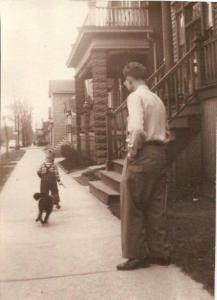Toni Morrison exhorts us to read Ta-Nehisi Coates’ book, Between the World and Me, by just putting it out there: “This is required reading.” The only way I could expand on that perfect direction is to possibly add, “Then, re-read.” I hope over the next many months to come back to Coates’ writing and thinking again and again, but today I focus on his notion of whiteness.
When I first read his words, I went into a prolonged reverie.
These new people are, like us, a modern invention. But unlike us, their new name has no real meaning divorced from the machinery of criminal power. The new people were something else before they were white — Catholic, Corsican, Welsh, Mennonite, Jewish — and if all our national hopes have any fulfillment, then they will have to be something else again. Perhaps they will truly become American and create a nobler basis for their myths.
My writing over the past year has sharpened my childhood memories, adding detail and nuance where little existed for decades. I do not believe that I am fabricating my childhood, but in reconsolidating these recollections, more of their component parts pop up. A story that for years was thematically organized or filed in the box called “crap my mother did,” has been re-filed in a new bin called “how my mother coped.” In the reconsolidated story, new details connect her behavior to her hardships as an orphan and how foreign my childhood was to her.
 Another series of stories from my past were encoded in my memory under something likely titled “people on the street.” These people included our nearby neighbors, family friends, my parents’ co-workers, people from our Catholic parish, local merchants, and scores of people, mostly men, who delivered things in carts, wagons, and trucks. Ice, coal, oil, produce — these were all brought to the houses in our poor and working class neighborhood. Ice and oil came in trucks. The ice man did not wear a uniform, but rather had a heavy leather sort of saddle that covered his shoulder and upper back, protecting them from the cold blocks of ice and the sharp tongs they used to lift them. Oil was delivered by men in overalls, blacked by the residue of their deliveries.
Another series of stories from my past were encoded in my memory under something likely titled “people on the street.” These people included our nearby neighbors, family friends, my parents’ co-workers, people from our Catholic parish, local merchants, and scores of people, mostly men, who delivered things in carts, wagons, and trucks. Ice, coal, oil, produce — these were all brought to the houses in our poor and working class neighborhood. Ice and oil came in trucks. The ice man did not wear a uniform, but rather had a heavy leather sort of saddle that covered his shoulder and upper back, protecting them from the cold blocks of ice and the sharp tongs they used to lift them. Oil was delivered by men in overalls, blacked by the residue of their deliveries.
Coal was at first conveyed by horse-drawn wagon and later open trucks, the crew hanging off the sides of the trucks with their heavy leather buckets over their shoulders or on hooks to their sides. No uniforms for them, but they wore caps imprinted with the supplier’s logo. Produce was also initially brought by wagon, but later it came by trucks with retracting sides so customers could select what they wanted weighed for purchase.
Services also came to us. A small cart — pulled by a mule? A pony? — brought the knife sharpener. A bigger wagon, with at least two horses brought the rag and junk collector. These services seemed to come on a schedule all their own, though. However, I was so young, so I might have merely missed the seasons of their arrival.
 We didn’t have a car. We walked or took public transportation, though this would still have been a treat. We didn’t think of ourselves as poor, but as working people. We were Catholic, but in a sort of Russian-Orthodox-Irish-Traveller-Assimilated-Jewish sort of way. But that Catholicism didn’t look different from the Catholicism of our neighbors. We were German, Irish, Polish, Russian. We were different in customs from our Mexican, Lutheran, Baptist, Italian, Black neighbors.
We didn’t have a car. We walked or took public transportation, though this would still have been a treat. We didn’t think of ourselves as poor, but as working people. We were Catholic, but in a sort of Russian-Orthodox-Irish-Traveller-Assimilated-Jewish sort of way. But that Catholicism didn’t look different from the Catholicism of our neighbors. We were German, Irish, Polish, Russian. We were different in customs from our Mexican, Lutheran, Baptist, Italian, Black neighbors.
The words of Ta-Nehisi Coates written to his son reminded me powerfully that we were not white then.
That came later. And I recall not liking it.